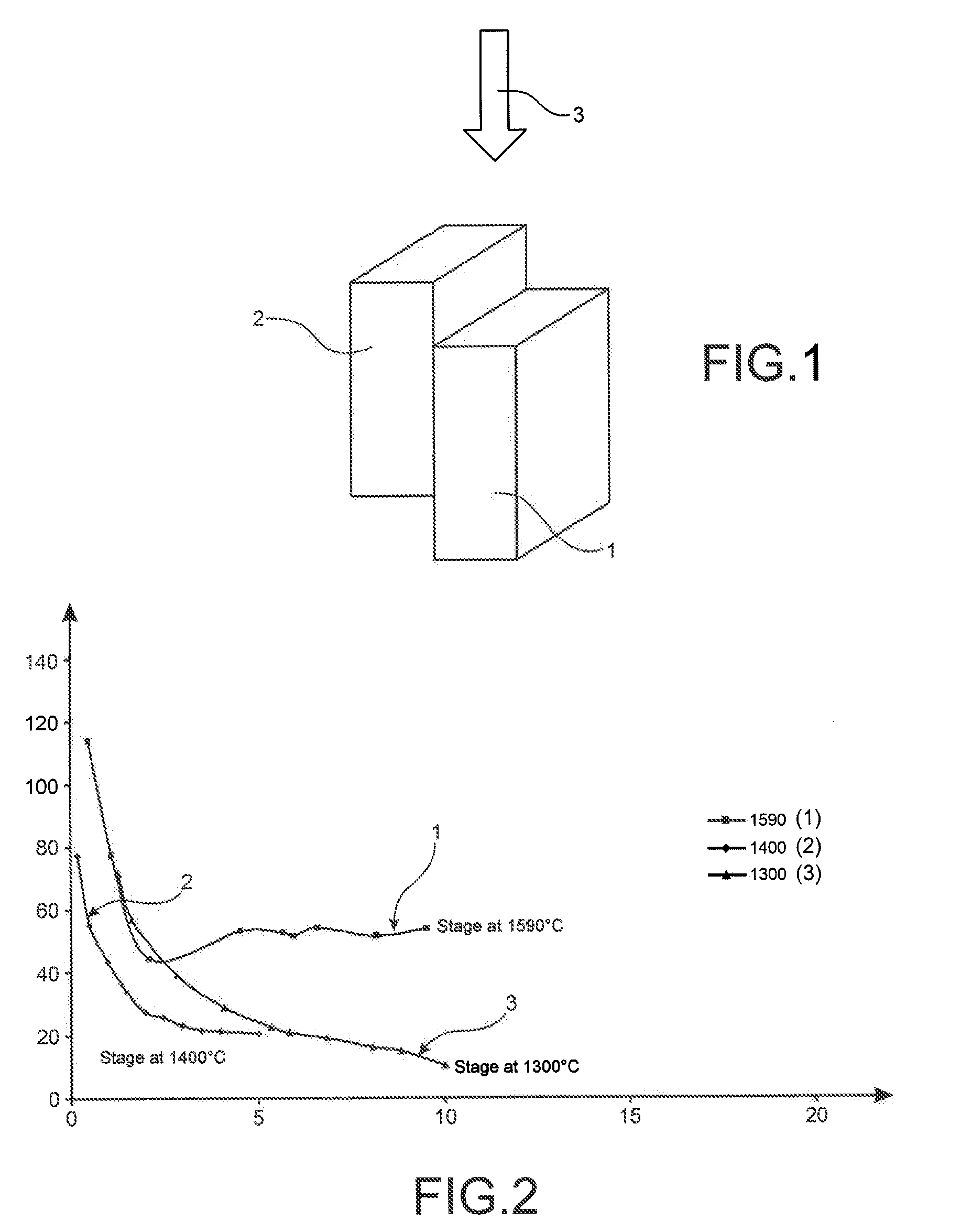Process for the Moderately Refractory Assembling of Articles Made of SiC-Based Materials by Non-Reactive Brazing in an Oxidizing Atmosphere, Brazing Compositions, and Joint and Assembly Obtained by this Process
- Summary
- Abstract
- Description
- Claims
- Application Information
AI Technical Summary
Benefits of technology
Problems solved by technology
Method used
Image
Examples
example 1
[0165]This example describes applied drop tests (“Essais de goutte posée” in French) and bond strength tests performed with a brazing alloy or brazing composition according to the invention having the composition: 62% by mass of SiO2-15% by mass of Al2O3-23% by mass of CaO on sintered pure α-SiC.
[0166]a) Preparation of the Brazing Composition
[0167]The targeted brazing composition: 62% by mass of SiO2-15% by mass of Al2O3-23% by mass of CaO, was prepared from SiO2 powder, mullite powder (defined compound 3Al2O3-2SiO2) and powder of the compound CaO—SiO2.
[0168]These powders are weighed out, adhering to the proportions, and are then mixed together and ground in a mortar. The powder mixture is then subjected to a stage of 4 hours in air at 1590° C. After cooling, a glass with a melting point of about 1200° C. is obtained. The analyses performed with an X-ray microprobe indicate that the mixture is homogeneous and that the mass composition is 61.2% SiO2-15.0% Al2O3-23.4% CaO.
[0169]The gl...
example 2
[0176]This example describes the preparation of bonds or assemblies between two articles made of sintered pure α-SiC silicon carbide, by performing the brazing process according to the invention (brazing in sandwich configuration), and using a brazing composition according to the invention composed of (consisting of) 62% by mass of SiO2-15% by mass of Al2O3-23% by mass of CaO, and mechanical tests or trials performed on these assemblies.
[0177]a) Preparation of the Brazing Composition and of the Articles to be Assembled
[0178]The glass is produced according to the procedure described in Example 1. It is then recovered and ground in a mortar. It is then mixed with an organic cement, Nicrobraz®, which is both viscous and tacky, so as to obtain a paste that is easy to spread.
[0179]The articles made of sintered SiC are plates 20×20 mm2 in size and 1 mm thick or discs 15 mm in diameter and 5 mm thick.
[0180]The two SiC surfaces to be assembled are degreased in an organic solvent, and then d...
example 3
[0199]This example describes the preparation of bonds or assemblies between two articles made of sintered pure α-SiC silicon carbide, by performing the brazing process according to the invention (brazing in capillary configuration) using a brazing composition according to the invention composed of 62% by mass of SiO2-15% by mass of Al2O3 and 23% by mass of CaO.
[0200]a) Preparation of the Brazing Composition and of the Articles to be Assembled
[0201]The brazing paste is prepared as described in Example 2. The sintered SiC articles are plates 15×15 mm2 in size and 5 mm thick.
[0202]The two SiC surfaces to be assembled are degreased in an organic solvent, and then dried.
[0203]The substrates or articles are placed in contact with an offset of a few mm so as to leave a space to apply the brazing paste close to the joint (this configuration is known as the capillary configuration). The paste is applied with a spatula to the available surface at the edge of the joint. The amount applied is a...
PUM
| Property | Measurement | Unit |
|---|---|---|
| Temperature | aaaaa | aaaaa |
| Temperature | aaaaa | aaaaa |
| Temperature | aaaaa | aaaaa |
Abstract
Description
Claims
Application Information
 Login to View More
Login to View More - R&D
- Intellectual Property
- Life Sciences
- Materials
- Tech Scout
- Unparalleled Data Quality
- Higher Quality Content
- 60% Fewer Hallucinations
Browse by: Latest US Patents, China's latest patents, Technical Efficacy Thesaurus, Application Domain, Technology Topic, Popular Technical Reports.
© 2025 PatSnap. All rights reserved.Legal|Privacy policy|Modern Slavery Act Transparency Statement|Sitemap|About US| Contact US: help@patsnap.com

